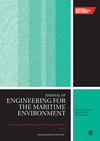基于海洋雷达测量资料的海浪场可预测性研究
IF 1.5
4区 工程技术
Q3 ENGINEERING, MARINE
Proceedings of the Institution of Mechanical Engineers, Part M: Journal of Engineering for the Maritime Environment
Pub Date : 2023-07-10
DOI:10.1177/14750902231184096
引用次数: 1
摘要
本研究以海洋雷达测量资料为基础,考虑海浪场的可预测性。利用基于三维fft的雷达图像序列重建得到的相位分辨分量进行波场预测,并介绍了两种不同的预测方法:(i)通过调整各分量的频率和相位进行基于快照数据的预测;(ii)通过对重建波场的数据同化进行基于时空数据的预测。在此基础上,推导了矩形和环形两种不同形状测量域下可预测区域的时间演化规律。为了验证所提出的波传播建模方法,对反射几何阴影效应生成的合成雷达图像进行了数值模拟,并与推导出的可预测区域进行了预测精度检验。最后,从预测技术、重构域规格和运动测量等方面讨论了以雷达位置可预测时间范围为代表的预测性能。本文章由计算机程序翻译,如有差异,请以英文原文为准。
Study on predictability of ocean wave fields based on marine radar measurement data
In this study, the predictability of ocean wave fields is considered based on marine radar measurement data. Phase-resolved components obtained by applying 3D FFT-based reconstruction to a sequence of radar images are utilized for wave field prediction, and two different prediction approaches are introduced: (i) snapshot data-based prediction through the adjustment of the frequency and phase of each component, and (ii) spatiotemporal data-based prediction through the data assimilation for reconstructed wave fields. Furthermore, the time evolution of a predictable zone is derived for different shapes of measurement domains including rectangular and ring-shaped domains. To validate the proposed wave propagation modeling method, numerical simulations are conducted on synthetic radar images created by reflecting geometrical shadowing effects, and the prediction accuracy is examined in relation to the derived predictable zone. Lastly, the forecasting performance, which is represented by the predictable time range at a radar location, is discussed with respect to the prediction techniques, specifications of the reconstruction domain, and moving measurements.
求助全文
通过发布文献求助,成功后即可免费获取论文全文。
去求助
来源期刊

CiteScore
3.90
自引率
11.10%
发文量
77
审稿时长
>12 weeks
期刊介绍:
The Journal of Engineering for the Maritime Environment is concerned with the design, production and operation of engineering artefacts for the maritime environment. The journal straddles the traditional boundaries of naval architecture, marine engineering, offshore/ocean engineering, coastal engineering and port engineering.
 求助内容:
求助内容: 应助结果提醒方式:
应助结果提醒方式:


